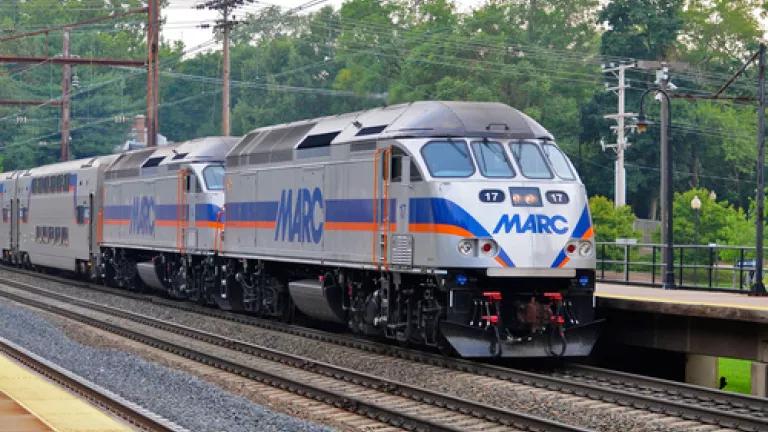
MARC train in Odenton, Maryland. Photo courtesy of Ryan Stavely.
Yes, you read that headline right. Senators Corker (R-TN) and Murphy (D-CT) are backing a 12-cent-per-gallon gasoline tax increase to shore up the nation’s highway trust fund, and getting praised for it to boot.
Outlays are outpacing revenues, pulling the balance precariously close to zero at which point the federal government will have to start reneging on support for state and local transportation programs and projects. This is not a new problem. In fact, the last transportation law spanned just two years due to this fiscal crunch. Congress made ends meet in part by changing pension and retirement policies, on the heels of other infusions into the trust fund from general fund revenues.
That law expires in September, and the fiscal situation is actually deteriorating even faster. Last month Transportation Secretary Anthony Foxx sent a letter to state transportation directors informing them of impending shortfalls as early as August, at which time he will “keep you apprised of our specific cash management plans.”
To be clear, this is not necessarily the end of the world. If Congress can’t get its act together to move a new transportation law – and remember it took three years to pass the last two-year law, Moving Ahead for Progress in the 21st Century or MAP-21 – cities, counties and states can help fill the gap. As longtime transportation curmudgeon Ken Orski noted in his Innovation Briefs publication recently:
“Surveys by the National Council of State Legislatures, AASHTO and the American Road and Builders Association (ARTBA) have documented transportation-related revenue initiatives in 26 states. In addition, last November, voters approved four local bond referenda and 12 measures to increase local transportation sales taxes. More such grassroots initiatives are expected this coming November. These measures are cumulatively generating millions of additional dollars for state and local transportation programs and offer a partial antidote to stagnant federal revenue.”
But the key words in this assessment are “partial antidote,” in recognition of the hard fact that the national share accounts for at least one-fifth of the nation’s total investment in transportation at $40-50 billion a year depending on revenues from gas tax receipts. The Bipartisan Policy Center and Eno Center for Transportation examined potential consequences of a reduced federal role in transportation and found that most states would take a huge hit. In fact, as of that publication (2012) 27 state programs relied on the federal share for 25-40 percent of their capital investment programs (pdf of that report is here).
In addition to accounting for such a large share, national investments leverage jumps forward in local and state transportation programs and systems. This is especially the case with federal programs that spur virtuous competition between localities and states. For example, the New Starts program for transit projects such as light-rail and bus-rapid-transit lines, which the Bipartisan Policy Center also analyzed as a potential model for competitive grantmaking. Other notable examples include the Bush Administration’s Urban Partnership Program, the Transportation Infrastructure Finance and Innovation Act (TIFIA) included in 1998’s TEA-21 law and reauthorized and dramatically expanded in MAP-21, and arguably the most wildly popular yet of all transportation programs – TIGER, which roared into live in the 2009 American Recovery and Reinvestment Act.
The Obama Administration has proposed expansion of TIGER, as well as a new program that would finally help move transportation planning and policy – not just project development, as with the previous competitive programs listed above – dubbed “Fixing And Accelerating Surface Transportation” (FAST) in their new bill GROW AMERICA. As I discuss in another entry, in terms of overall program architecture and components such as FAST, this bill is a great fit for a 21st century which demands metropolitan innovation, increased investment in modes other than rural highways, data and technological advances as well as real accountability for achieving specific social, economic and environmental metrics.
Thanks to Senators Murphy and Corker, as well as Secretary Foxx and the Obama Administration, and EPW Chairman Boxer and her Committee with their own reauthorization bid, real momentum seems to be building towards securing investments in the transportation infrastructure that undergirds U.S. economic competitiveness in the world.
These leaders are leading the way to bigger and better investments in transportation, and now is the time for others to take up the charge. Let’s get to work.
